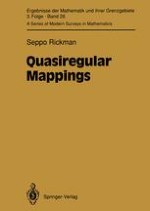Quasiregular Mappings extend quasiconformal theory to the noninjective case.They give a natural and beautiful generalization of the geometric aspects ofthe theory of analytic functions of one complex variable to Euclidean n-space or, more generally, to Riemannian n-manifolds. This book is a self-contained exposition of the subject. A braod spectrum of results of both analytic and geometric character are presented, and the methods vary accordingly. The main tools are the variational integral method and the extremal length method, both of which are thoroughly developed here. Reshetnyak's basic theorem on discreteness and openness is used from the beginning, but the proof by means of variational integrals is postponed until near the end. Thus, the method of extremal length is being used at an early stage and leads, among other things, to geometric proofs of Picard-type theorems and a defect relation, which are some of the high points of the present book.
